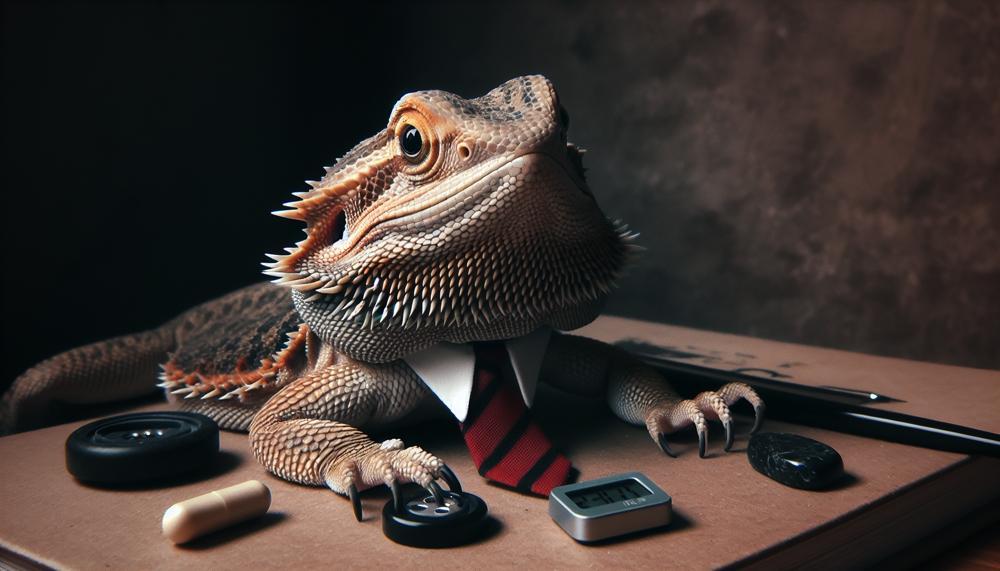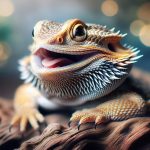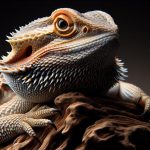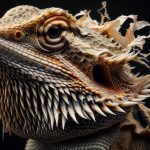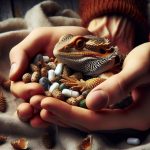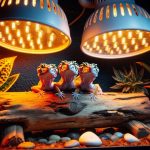Have you ever caught your bearded dragon chilling on its back and thought, “What in the world?” It’s not just you. This quirky habit has puzzled and concerned many a reptile enthusiast. As we dive into the mysterious world of bearded dragons flipping onto their backs, we’ll uncover the facts, debunk myths, and offer insights that’ll leave you both informed and entertained.
So, Why Do Bearded Dragons Flip On Their Back?
Bearded dragons can flip on their backs for a number of reasons, including:
- Calcium deficiency: Weakness in the limbs, falling, shakiness, and/or seizures
- Breathing: Bearded dragons use their intercostal muscles to lift their lungs, front legs, and abdominal organs when they flip on their backs
- Not regular: Bearded dragons don’t usually lay on their backs, so you should pay attention if your bearded dragon does
Bearded dragons are cold-blooded, so they need external heat sources to regulate their body temperature.
Join us on this engaging journey into the upside-down world of bearded dragons. Whether you’re a seasoned keeper or just curious about these charismatic creatures, there’s something here for everyone. Let’s flip the script on what you thought you knew about bearded dragons.
Contents
- 1 Why Do Bearded Dragons Flip on Their Backs? Understanding the Behavior
- 2 Is Flipping on the Back Normal for Bearded Dragons? Exploring the Phenomenon
- 3 How to Prevent Bearded Dragons from Flipping onto Their Backs: Helpful Tips
- 4 What Should I Do If My Bearded Dragon Flips on Its Back? Immediate Actions to Take
- 5 Potential Dangers of Bearded Dragons Flipping on Their Backs: A Concerned Owner’s Guide
- 6 Is Flipping on the Back Harmful to Bearded Dragons? Expert Insights
- 7 Common Reasons Behind Bearded Dragons Flipping on Their Backs: An In-Depth Analysis
- 8 Bearded Dragon Behavior: Decoding the Meaning of Flipping on the Back
- 9 How to Safely Turn a Flipped Bearded Dragon Back onto Its Feet: Step-by-Step Guide
- 10 Preventing Bearded Dragons from Flipping on Their Backs: Best Practices and Proven Techniques
- 11 Conclusion
Why Do Bearded Dragons Flip on Their Backs? Understanding the Behavior
Bearded dragons flip onto their backs for various reasons, often signalling distress, discomfort, or an underlying health concern. Here, we dissect the motives behind such behaviour:
| Reason | Description | Prevention |
|---|---|---|
| Defensive Mechanism | Flipping to startle predators. | Minimise stress and threats. |
| Health Issues | Signs of infections or diseases. | Regular health check-ups. |
| Unsuitable Habitat | Incorrect temperature/lighting. | Optimise enclosure conditions. |
| Injury/Illness | Could be due to trauma or illness. | Inspect for injuries, provide care. |
| Gravid Females | Nesting behaviour for egg-laying. | Offer suitable nesting area. |
| Temperature Issues | Trying to warm up their belly. | Monitor and regulate temperatures. |
| Stress or Fear | Response to stressful situations. | Create a calm, stable environment. |
By understanding and addressing these factors, you can help prevent your bearded dragon from flipping and ensure its well-being.
Is Flipping on the Back Normal for Bearded Dragons? Exploring the Phenomenon
Flipping over is not a routine for bearded dragons. When these creatures take a tumble onto their backs, it’s a signal that warrants attention. Here’s a breakdown of the whys and wherefores behind this odd spectacle:
| Reason | Description | Action Required |
|---|---|---|
| Neurological Conditions | Issues such as atadenovirus or brain anomalies might throw off balance. | Seek vet advice. |
| Nutrient Deficiencies | Lack of calcium or dehydration can lead to weakness, causing flips. | Adjust diet and hydration. |
| Environmental Factors | Slippery or unstable surfaces can cause accidental flips. | Check and modify habitat. |
| Health Issues | Diseases like metabolic bone disease or yellow fungus affect coordination. | Consult a reptile vet promptly. |
| Defensive Behaviour | Playing dead to escape predators, though rare in captivity. | Observe for repeated instances. |
| Physical Injury | Head trauma from falls may result in disorientation. | Prevent falls and monitor for injury. |
In essence, a flipped bearded dragon could be in a pickle, and it’s down to us to fathom the issue. Whilst a one-off might be a mere slip, regular occurrences are a red flag. If your scaly mate is upside-down, gently set them right and watch for other oddities in behavior.
A trip to the vet might be in order, especially if flips are frequent. Proper lighting, diet, and a safe enclosure can keep your bearded buddy from going topsy-turvy.
How to Prevent Bearded Dragons from Flipping onto Their Backs: Helpful Tips
To shield bearded dragons from the peril of flipping onto their backs, consider these strategic tips:
| Aspect | Details | Action |
| Habitat | Correct temperature, UV lighting, space | Monitor and adjust as needed |
| Health | Regular vet check-ups | Schedule routine visits |
| Substrate | Non-slippery, offers traction | Choose reptile carpet or textured tiles |
| Enclosure | Securely arranged furniture | Check and rearrange periodically |
| Handling | Gentle, secure support | Always supervise and offer a safe landing |
| Exercise | Regular, safe activity | Provide opportunities for movement |
| Diet | Balanced, prevents obesity | Control portions and offer variety |
| Behaviour | Watch for distress or illness | Be vigilant and responsive |
What Should I Do If My Bearded Dragon Flips on Its Back? Immediate Actions to Take
If your bearded dragon flips on its back, follow these immediate steps:
| Action | Description | Reason |
| Gentle Righting | Flip the dragon to its belly with care. | Prevents respiratory distress and further disorientation. |
| Observation | Watch for any unusual behavior post-flip. | Helps identify potential neurological issues or injuries. |
| Environmental Check | Inspect the habitat for risks. | Eliminates future flipping incidents caused by the enclosure setup. |
| Hydration | Offer water to the dragon. | Tackles dehydration, a possible cause of flipping. |
| Nutrition | Review and adjust diet and supplements if needed. | Prevents deficiencies that can lead to health issues. |
| Veterinary Consultation | Contact a vet if abnormalities persist. | Professional diagnosis and treatment for underlying conditions. |
Remember, flipping might indicate a health issue that requires attention. Keep a sharp eye out for any repeat performances or additional symptoms that might necessitate a visit to the vet.
Potential Dangers of Bearded Dragons Flipping on Their Backs: A Concerned Owner’s Guide
Bearded dragons are robust creatures, yet flipping onto their backs can spell trouble. Let’s dive into the risks and how to avert such upsets.
Hazards of Upside-Down Beardies
When a bearded dragon ends up belly-up, it’s like a car overturned in the wild—it’s not where it’s meant to be. This abnormal state can usher in a host of perils:
- Breathing bother: When flipped, these reptiles struggle to inhale, as their lungs aren’t built for this topsy-turvy stance.
- Heat havoc: Unable to scuttle to shade, an upside-down dragon risks overheating, particularly under the fierce gaze of a basking lamp.
- Stress spikes: Imagine the panic of finding yourself flipped. It’s the same for your scaled companion, leading to a surge in stress levels.
- Injury: Their limbs flail, their head might knock against hard surfaces, and their delicate spine could suffer.
| Risk | Consequence | Prevention Strategy |
| Breathing Difficulty | Respiratory strain, potential suffocation | Immediate righting, vet check for underlying issues |
| Overheating | Heat stress, organ damage | Monitor temperatures, provide ample shade |
| Stress | Behavioural changes, immunosuppression | Stable environment, regular handling |
| Injury | Bruises, fractures, spinal damage | Safe enclosure design, no slippery surfaces |
Sidestepping the Flip
To shield your bearded buddy from the dangers of flipping, let’s look at some proactive pointers:
- Home sweet home: Craft a cozy den with no steep slopes or slippery spots. A spacious pad with basking rocks and branches positioned just right will do the trick.
- Keep your cool: Keep a watchful eye on the mercury. The basking spot should be warm, not scorching, to prevent a heated mishap.
- Hidey-holes: Offer nooks and crannies for your dragon to duck into when the world gets a bit much. It’s their personal chill-out zone.
- Vet visits: Like taking your car in for a service, regular check-ups with the vet can catch any sneaky health snags that might cause a flip.
By staying sharp and setting up a proper home, you’ll keep your bearded dragon right side up and chipper.
Is Flipping on the Back Harmful to Bearded Dragons? Expert Insights
Flipping onto their backs can spell trouble for bearded dragons, chaps. It’s a bit like us getting all turned around – it’s not their usual tea and could point to a hitch in their get-up.
| Issue | Consequences | Prevention |
|---|---|---|
| Neurological Conditions | Loss of balance, seizures | Seek veterinary care |
| Nutrient Deficiencies | Weakness, potential metabolic bone disease | Proper diet, UVB lighting, supplements |
| Respiratory Compression | Breathing difficulties | Immediate corrective action |
When a bearded dragon ends up belly-up, it’s not just barmy, it’s a sign that something could be off-kilter. Could be they’re feeling under the weather due to an infection, or they’ve taken a knock on the noggin resulting in head trauma. Dehydration’s another blighter that can cause them to flip, and let’s not overlook the possibility of a brain tumor.
Seeing a bearded dragon flipped over once might not ring alarm bells, but if it’s a recurring theme, that’s a red flag, and you’d best take the little mate to a vet. After all, these scaly pals rely on us to keep a sharp eye out for their well-being.
It’s worth noting that these critters might flip over as a ruse to play possum and fool predators. But in the comfy confines of their terrariums, such antics are a sign that all’s not well.
Common Reasons Behind Bearded Dragons Flipping on Their Backs: An In-Depth Analysis
Bearded dragons might flip onto their backs for a variety of reasons, many of which are health-related and require swift attention.
Health Conditions
- Metabolic Bone Disease (MBD): MBD weakens bones, leading to potential flipping.
- Neurological Disorders: Conditions like atadenovirus or brain tumors could disrupt motor functions.
- Nutrient Deficiencies: Lack of calcium and vitamin D3 can cause neurological issues.
Environmental Causes
- Accidental Falls: While climbing or being clumsy, dragons could tumble and land awkwardly.
- Dehydration: Electrolyte imbalance due to inadequate hydration affects muscle function.
Behavioral Factors
- Playing Dead: In rare instances, as a defense mechanism against perceived threats.
Prevention Strategies
| Proper Diet | Ensure a balanced diet with adequate calcium. |
| UVB Lighting | Provide sufficient UVB exposure for vitamin D3 synthesis. |
| Safe Habitat | Minimize climbing hazards and monitor for signs of dehydration. |
| Veterinary Care | Regular check-ups to catch and treat health issues early. |
If you stumble upon your bearded dragon on its back, gently help it to its feet promptly. Should this occur frequently, a trip to the vet is warranted to rule out serious health concerns.
Bearded Dragon Behavior: Decoding the Meaning of Flipping on the Back
Bearded dragons flipping onto their backs can be startling and often indicates that something’s amiss. This behaviour is not a regular stunt in their repertoire and should be taken seriously.
Here’s a breakdown of potential causes:
| Reason | Description | Owner Interpretation |
|---|---|---|
| Neurological Issues | Misfires in the nervous system due to injury or disease. | Seek veterinary advice; could signify severe health problems. |
| Nutrient Deficiencies | Lack of calcium or other essential nutrients affecting muscle function. | Re-examine diet, ensure proper supplementation, and UVB exposure. |
| Environmental Factors | Clumsy falls or unstable perching spots. | Inspect and secure the habitat for safety. |
| Playing Dead | A defensive tactic to evade perceived threats. | Assess for stressors in the environment that may trigger this behaviour. |
| Illness | Bacterial/viral infections, head trauma, dehydration, or metabolic issues. | Immediate veterinary consultation is necessary. |
Interpreting the Flip
If you spot your scaly mate belly-up, don’t dilly-dally. Each flip could be a cry for help or a sign of distress. First, gently right your bearded dragon and observe any other unusual behaviour or symptoms. Then, take swift action:
- Health Check: Look for signs of injury, infection, or dehydration.
- Habitat Audit: Confirm your pet’s environment is hazard-free and well-suited to their needs.
- Dietary Review: Make sure your bearded buddy’s getting the right nutrients, especially calcium and vitamins.
- Stress Signals: Consider if there’s anything causing your dragon discomfort or fear.
- Professional Help: When in doubt, a vet’s shout is the best route.
Remember, this isn’t something to be taken lightly, and your vigilance could very well save your bearded dragon from serious health issues.
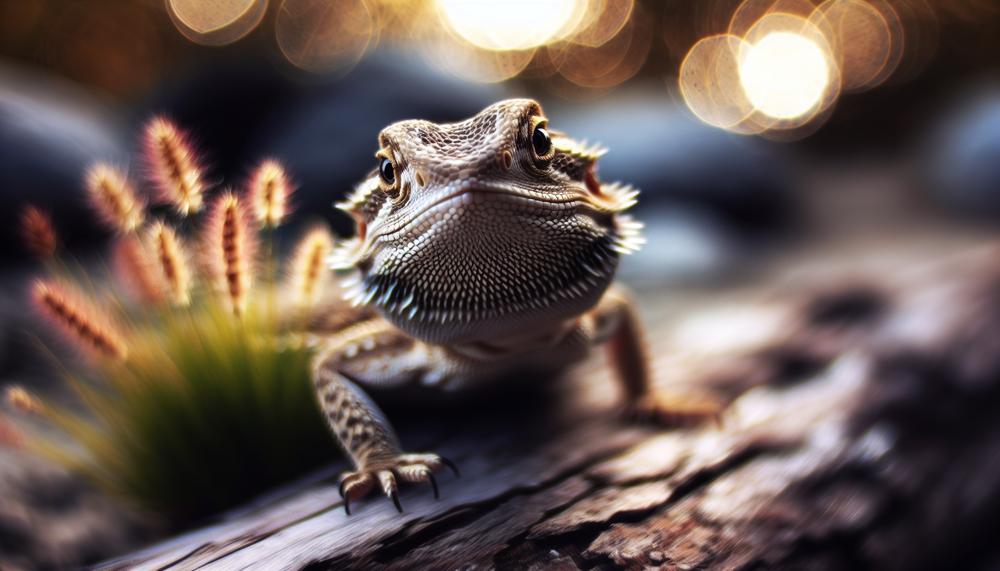
How to Safely Turn a Flipped Bearded Dragon Back onto Its Feet: Step-by-Step Guide
If you discover your bearded dragon flipped onto its back, it’s crucial to rectify the situation with care. Here’s a precise guide:
| Step | Action | Details |
| Evaluate | Stay Calm | Check for signs of injury or distress. |
| Enlist Help | Get Assistance | Another person can help stabilize the process. |
| Prepare Landing | Soft Setup | Create a cushioned area for the dragon to land on. |
| Gentle Lift | Supportive Lift | Pick up the dragon with care, supporting its entire body. |
| Roll-Over | Assisted Turn | Gently roll the dragon onto its stomach with help. |
| Observe | Monitor Behaviour | Look for any discomfort or stress post-flip. |
| Vet Advice | Consult Professional | If necessary, get a vet to check your dragon. |
Keep in mind, each bearded dragon has its own quirks and may flip for a variety of reasons. It’s pivotal to understand these could range from harmless antics to serious health concerns.
Preventing Bearded Dragons from Flipping on Their Backs: Best Practices and Proven Techniques
To keep a bearded dragon from flipping onto its back, it’s essential to create an environment that promotes stability and well-being. Here’s a rundown of practical steps you can take:
| Aspect | Technique | Reason |
| Habitat | Spacious, clutter-free | Prevents falls and flips |
| Substrate | Traction-friendly | Reduces slipping |
| Accessories | Secure ramps, branches | Facilitates safe climbing |
| Diet | Balanced, obesity prevention | Enhances mobility and health |
| Exercise | Supervised exploration | Encourages strength and balance |
| Health checks | Annual vet visits | Addresses underlying issues |
| Care | Quick, safe correction | Immediate assistance if flipped |
By following these guidelines, you’ll foster a habitat that not only deters your bearded dragon from flipping but also champions its overall health and happiness.
If you suspect your scaly mate is frequently flipping despite these measures, a trip to the vet is in order to rule out any underlying health concerns.
Conclusion
The sight of your scaly pet flipping on their back might cause panic in the vibrant and complex world of bearded dragon care. This article has examined the many causes of this behavior, ranging from innate defensive systems to grave health risks. We’ve dispelled misconceptions, stressed the value of a pristine ecosystem, and underlined the need of routine veterinarian examinations.
Bearded dragons may flip in a desperate attempt to ward off predators, but more often than not, it indicates a problem with their health, environmental stresses, or poor nutrition. Flipping often is a blatant distress signal in captivity that calls for a careful assessment of their living circumstances and maybe a medical examination.
Carefully planning the habitat setup is essential to reducing these dangers, assuring the proper temperature gradients, UV illumination, and suitable substrates. To keep one’s physical state in excellent shape, handling should be kind and exercise encouraged. In order to promote general health and avoid obesity, a balanced diet is essential.
React carefully if you discover your bearded dragon upside down. Gently correct them, observe their behavior closely, and look for any dangers in the environment. It’s time to see a veterinarian if the flipping continues.
Ultimately, you can make sure your bearded dragon has a happy, healthy life—right side up—by being aware of the reasons for this behavior and taking proactive measures to remedy them.

